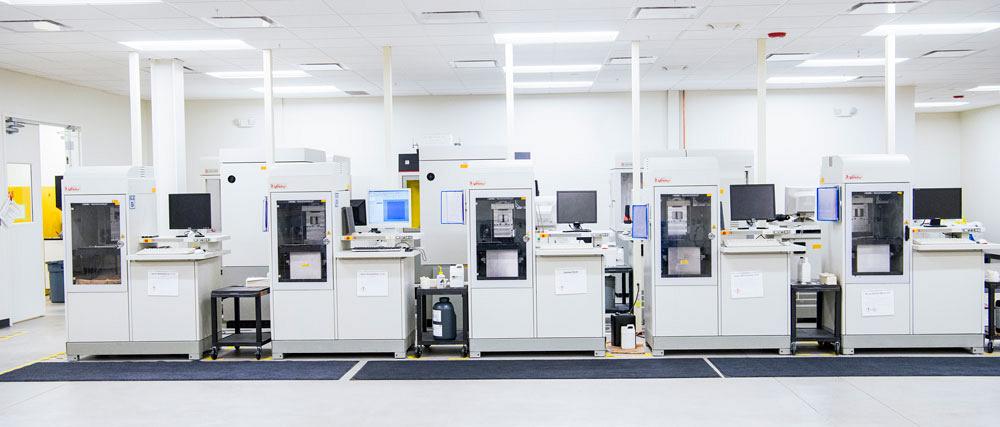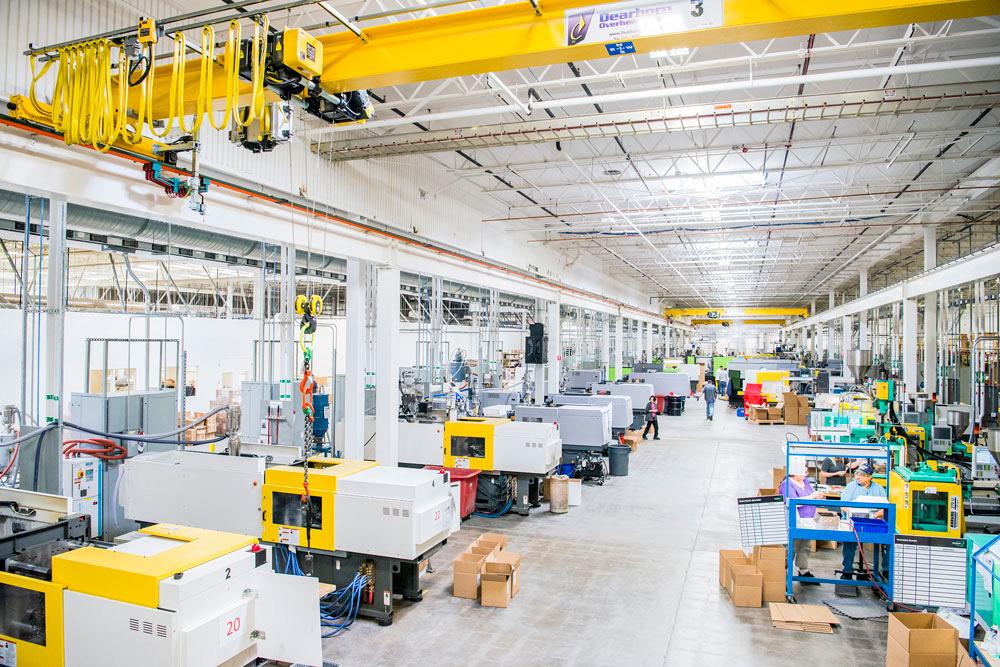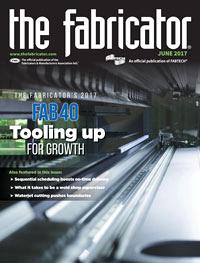Senior Editor
- FMA
- The Fabricator
- FABTECH
- Canadian Metalworking
Categories
- Additive Manufacturing
- Aluminum Welding
- Arc Welding
- Assembly and Joining
- Automation and Robotics
- Bending and Forming
- Consumables
- Cutting and Weld Prep
- Electric Vehicles
- En Español
- Finishing
- Hydroforming
- Laser Cutting
- Laser Welding
- Machining
- Manufacturing Software
- Materials Handling
- Metals/Materials
- Oxyfuel Cutting
- Plasma Cutting
- Power Tools
- Punching and Other Holemaking
- Roll Forming
- Safety
- Sawing
- Shearing
- Shop Management
- Testing and Measuring
- Tube and Pipe Fabrication
- Tube and Pipe Production
- Waterjet Cutting
Industry Directory
Webcasts
Podcasts
FAB 40
Advertise
Subscribe
Account Login
Search
The many ways to manufacture a part
Metal fabrication, stamping, machining, plastic injection molding—the many ways to make a part at Tenere
- By Tim Heston
- May 31, 2017
- Article
- Metals/Materials
The company’s Latin name belies its culture or perfectly suits it, depending on how you interpret it. Meaning “to hold,” Tenere was founded in 1993 as a holding company (as its name suggests) that purchased two family-run Wisconsin operations, Hansman Industries and Progressive Tool & Design. Two years later it purchased Denver Die and Molding, a plastic injection molder in Lakewood, Colo. And in 2012 the company was sold to The Watermill Group, a private equity firm with various holdings, including Quality Metalcraft in Detroit and The Plastics Group in Willowbrook, Ill.
Tenere could have easily operated as its holding company namesake, an umbrella organization over two independent entities, one in plastics and another in sheet metal and machining. But that’s not what happened.
The company now goes to market under the “One Tenere” message. As Watermill’s website put it, “Where others see a metals and plastics parts fabricator with customer concentration and limited strategic direction, we envision a leading-edge design and manufacturing firm delivering critical time-to-market advantages for a broad range of companies making fast-changing, high-performance products in rapidly growing end markets.”
You now can’t really interpret tenere, “to hold,” to mean a holding company. Instead, the company “holds” a project from its inception through its fruition, from prototyping through production, be it in plastic, metal, or both.
One Tenere
Collaboration between metals and plastics divisions has played a big part in the company’s growth. Some large customers, including those in the “cloud space” (server racks), turn to Tenere for both plastic and sheet metal components.
The sheet metal operation has picked up serious momentum in recent years. In one sense, the company’s collaboration between its plastics and metals divisions has transformed it into a major metal fabrication player. Adding to its Dresser and Somerset, Wis., metal fabrication plants, the company opened a third Wisconsin location, in Osceola, dedicated to sheet metal as well as production machining.
“Our sheet metal business grew so quickly in 2014 and 2015, we were busting at the seams,” said Audrey Hamilton, senior marketing manager. “We were renting space for assembly. It soon just didn’t make sense financially, and so we opened a new space in Osceola.”
“We’ve had a lot of upgrades in capital equipment in recent years too,” said Steve Harris, director of program management for Tenere’s metal division. “In the past four years [the metals division has] spent more than $4 million.” The purchases include new lasers, turret punch presses, and a press brake with automatic tool changes.
The metal side of the business has made a dramatic shift away from stamping and toward metal fabrication. According to Harris, four years ago about 40 percent of the metal division’s work involved hard tooling (stamping presses), 60 percent soft tooling (turret punch, laser, and press brakes).
“Last year we ran about 90 percent soft tooling, 10 percent hard tooling,” Harris said, adding that stamping work isn’t necessarily on a permanent decline. “This year we may end up doing about 70 percent soft tooling, 30 percent hard tooling.”
It all depends on the product mix, volumes, order frequency, and other variables, including where in the product life cycle Tenere’s work happens to be during a given year. But having both stamping and fabrication equipment also can be a competitive advantage. Quite often the company cuts some part features with a laser or turret punch, then completes the part with further punching and forming on a stamping press. “Having a blended solution [with both fabrication and stamping] often works in our favor,” Harris said.
On the plastics side, Tenere purchased Mountain Molding in Longmont, Colo., in 2015. In 2016 the plastics operation consolidated to one facility in the Denver suburb of Westminster, Colo.
Back on the metals side, in 2016 Tenere opened a greenfield plant in Monterrey, Mexico, in response to customer demand—not for stamping (at least in the short term), but for laser cutting, turret punching, press brake bending, and other soft-tool fabricating, as well as painting (there aren’t many low-volume painters in the area).
Although the company did transfer some machines from Wisconsin to Mexico, it hasn’t moved any work from the Midwest to south of the border. Instead, the Monterrey plant is serving nearby customers or customers who previously sourced work to Asia or other low-labor-cost areas.
For instance, historically the Wisconsin operation has landed a lot of part development work, then lost the job as the customer sent production to Asia. The idea is that the Monterrey location will allow Tenere to prevent that production work from going across the ocean. The company also plans to add stamping in Monterrey in the coming years as customer part programs mature.
Tenere has its own toolmaking capacity, both in sheet metal stamping and plastic injection molding, but it also offers customers the opportunity to source tooling elsewhere, including partners in Asia.
“Regardless, we’re going to support that tool from start to finish, whether it’s made by us or by someone else,” Hamilton said, “because we eventually have to run those tools, and they have to be good.”
Tooling development in plastics injection molding is critical, which is one reason that having rapid prototyping under the same roof in Colorado works so well. In 2013 Tenere bought rapid prototype company Protogenic and has since invested heavily in 3-D printing, including laser sintering and fused deposition modeling with resins. Most important, tooling experts for plastic injection molding work hand in hand with experts in prototyping. After all, what’s the point of prototyping if it can’t be manufactured cost-effectively?
Overmolding
One process in the Colorado plant perhaps best represents how the plastics and metals divisions work together. A piece of sheet metal is placed into a plastic injection molding die. The sheet has several strategically placed holes, but otherwise it looks like a plain laser-cut blank. The press cycles, and a sheet metal part overmolded with plastic emerges.
Overmolding usually results in a mechanical bond between the substrate (which at Tenere could be sheet metal, a machined metal part, or a different-durometer plastic) and a plastic overmold. For instance, with a sheet metal substrate, plastic can flow through holes or other features in the sheet metal, which create a mechanical connection that, with the right design, will be invisible in the completed workpiece.

Tenere offers 3-D printing of resin material. Rapid prototyping is under the same roof as the company’s plastic injection molding operation.
Why overmold? It’s sometimes done to create a desirable surface feel for a product, to ensure a certain feature isn’t electrically conductive, or to add a complex feature to the part surface.
It can sometimes make assembly much easier and less costly, as well as increase the strength of the mechanical connection. Typically, an overmolded connection is much more secure than a plastic component fastened to sheet metal during final assembly.
Say an original part design involves a sheet metal blank with a half-dozen shallow plastic flanges fastened along one side. Thing is, these flanges aren’t all identical, but instead must be fastened in a certain order. Alas, these flanges are intrinsic to the product’s function, so their shape and number can’t be changed. One design-for-manufacturability option would be to error-proof the assembly using tabs and slots. If the assembler grabs a part, it won’t fit unless it’s slotted into the right place.
This may work, but it still requires that the shop manage inventory replenishment for six different flanges. And if flanges are placed in the wrong bins, an assembler may spend time fishing for the part he needs. In other words, those six different flanges introduce a lot of complexity into assembly.
In this case, overmolding may be a viable option. A plastic injection molding tool could be designed so that the plastic molded over the sheet metal substrate would have those narrow flanges designed right into it. The part would then arrive at the contract manufacturer ready to go for the next stage of assembly—no intricate error-proofing or parts replenishment to worry about.
Overmolding also helps in dissimilar-material joining, such as creating a strong connection between metal and plastic. For instance, a threaded metal ring can be overmolded on its outside diameter with plastic, which in turn can be plastic-welded to the plastic components of a larger assembly.
The sizes and shapes of overmolded parts are dictated by the size of the tool, available tonnage in the injection molding press (Tenere’s largest is 720 tons), as well as how the plastic flows in the cavity between the substrate (be it sheet metal or another plastic) and the die surfaces.
“When overmolding, we need to understand their limitations [on the metal side] and our limitations [on the plastics side], and then we can design in features that take care of these issues,” said Jack Jesteadt, director of program development at Tenere’s plastics operation in Westminster. Limitations often involve acceptable tolerances. “We can either accommodate for tolerance issues in our tool, or we work with our metals division to find another solution.”
For instance, if sheet metal thickness variation affects overmolding accuracy, Jesteadt and his team may design spring-loaded features in the tool to account for it, or perhaps a hardened steel insert right at the pinch point (maybe only 0.050 in. wide) where the plastic stops flowing in the mold. At that point, the insert might rest on top of some sheets; in others that are slightly thicker, it may push into the sheet ever so slightly to keep the thickness in that critical area consistent for the overmold.
Some overmolded blanks even leave bend lines bare (with no plastic overmold) to allow for enough clearance for final forming in a press brake—a strategy that makes sense when, for instance, the shape of the fully formed part makes it impossible to remove from the overmolding die. (A part’s ability to be ejected properly from the die is a key factor in plastic injection molding overall.) Other times metal parts are overmolded after forming, if tolerances can be accounted for.
“Flowing the plastic around corners and over bends isn’t an issue, depending on the thickness of the plastic,” Jesteadt said. “What’s critical is where the flow of plastic ends. And we also need to be able to push the plastic to where it needs to go.”
Jesteadt described a hypothetical situation in which a sheet metal part is bent several times on a press brake, causing the tolerance window to stack up to ±0.020 in.
“We can’t possibly work with that,” Jesteadt said. “We need ±0.002 in. [positional tolerance for a feature where the plastic flow ends]. And, of course, we’re told that’s crazy; that’s not possible. So we work together, and often end up piercing the sheet metal with our [plastic injection molding] die. We get the tight tolerance we need, but we create it with our tool. We don’t expect it to be in the sheet metal part when it comes to us.”
Metal or Plastic?
Tenere does sell itself as a single source for both metal and plastic, which has advantages. Purchasing more parts from one supplier makes managing the supply chain simpler. And from an engineering perspective, Tenere experts can suggest design changes to ensure both plastic and metal components fit and work together as they should.
The firm does not offer plastics machining, but it does offer metal milling and turning in its Wisconsin facilities. Depending on the machined part, it may be more cost-effective to develop a tool to mold a piece out of plastic, if it can meet or exceed strength requirements and the designer’s original intent.
Volumes also play a role. For instance, Tenere may have a high-volume stamping job that requires a secondary operation. In this case—and, again, depending on the part design attributes, its complexity, and its strength requirements—it may be less expensive to mold the part out of plastic. Tenere’s metal presses are large enough to stamp two to three identical parts side by side, but engineers in Colorado may be able to design an eight-cavity mold.
Harris described a print the company received for a deep stainless steel box. The box could have been formed on a press brake. “But some of the curvatures on the radii would have been a nightmare,” Harris said. Sure, those wide radii could have been formed with bump-bending, but that would have added time and cost. The box also needed to be welded, which required a lot of grinding and polishing.
Tenere engineers looked at the print, saw the volumes requested, and immediately suggested that the entire box be made in a plastic injection molding press. “All the radii and contoured surfaces made much more sense in a plastic mold,” Harris said.
Harris has worked at Tenere for 17 years, and he’s worked in metal manufacturing—machining, stamping, and fabrication—since 1983. Jesteadt started his career in production machining, and before long he jumped over to moldmaking and tool design for plastics. He joined Tenere as a lead moldmaker in 2001.
Sheet metal fabrication, stamping, machining, moldmaking, plastics—their background exemplifies the evolution of process diversification and the quest to put a company in a unique competitive position. Their employer’s process mix theoretically wouldn’t be too difficult to duplicate; the shop isn’t full of proprietary equipment, after all. But the mix of expertise, in engineering and in the shop, is another story. Therein lies Tenere’s competitive advantage.
Photos courtesy of Tenere Inc., 715-247-4242, www.tenere.com.
About the Author

Tim Heston
2135 Point Blvd
Elgin, IL 60123
815-381-1314
Tim Heston, The Fabricator's senior editor, has covered the metal fabrication industry since 1998, starting his career at the American Welding Society's Welding Journal. Since then he has covered the full range of metal fabrication processes, from stamping, bending, and cutting to grinding and polishing. He joined The Fabricator's staff in October 2007.
subscribe now

The Fabricator is North America's leading magazine for the metal forming and fabricating industry. The magazine delivers the news, technical articles, and case histories that enable fabricators to do their jobs more efficiently. The Fabricator has served the industry since 1970.
start your free subscription- Stay connected from anywhere

Easily access valuable industry resources now with full access to the digital edition of The Fabricator.

Easily access valuable industry resources now with full access to the digital edition of The Welder.

Easily access valuable industry resources now with full access to the digital edition of The Tube and Pipe Journal.
- Podcasting
- Podcast:
- The Fabricator Podcast
- Published:
- 04/16/2024
- Running Time:
- 63:29
In this episode of The Fabricator Podcast, Caleb Chamberlain, co-founder and CEO of OSH Cut, discusses his company’s...
- Industry Events
16th Annual Safety Conference
- April 30 - May 1, 2024
- Elgin,
Pipe and Tube Conference
- May 21 - 22, 2024
- Omaha, NE
World-Class Roll Forming Workshop
- June 5 - 6, 2024
- Louisville, KY
Advanced Laser Application Workshop
- June 25 - 27, 2024
- Novi, MI


































